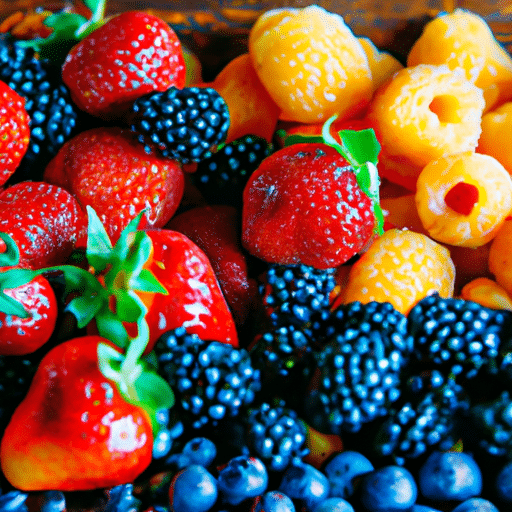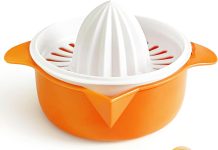Curious about the shelf life of your favorite blended smoothies in the fridge? Look no further! In this article, we will tackle the pressing question of how long these delectable concoctions actually last once stored in the chill of your refrigerator. So, if you’re wondering whether you can sip on that delicious fruity fusion for the next few days or if it’s time to bid farewell, stick around as we spill the beans (or, in this case, the berries) on the lifespan of blended smoothies in the fridge. Get ready to blend in with the knowledge!
Review contents
Factors Affecting the Shelf Life of Blended Smoothies
Blended smoothies are a delicious and nutritious way to incorporate fruits, vegetables, and other ingredients into our diet. However, their shelf life can vary depending on several factors. By understanding these factors, we can ensure that our smoothies stay fresh and safe to consume for as long as possible.
Ingredients
The ingredients used in a blended smoothie play a significant role in determining its shelf life. Fresh and high-quality ingredients will result in a longer-lasting smoothie. Fruits, vegetables, and other perishable ingredients should be at their peak ripeness and free from any signs of spoilage. Using overripe or spoiled ingredients can accelerate the spoilage process and reduce the shelf life of the smoothie.
Consistency
The consistency of a blended smoothie also affects its shelf life. Smoothies that have a thicker consistency tend to last longer compared to those with a watery consistency. This is because the thicker texture creates a barrier that helps slow down the oxidation process and prevents the growth of spoilage-causing bacteria.
Temperature
Temperature is a crucial factor in preserving the freshness of blended smoothies. Keeping them at a low temperature helps slow down the growth of bacteria and other microorganisms that contribute to spoilage. Refrigeration is the best way to store smoothies, as it maintains a cool and consistent temperature. Avoid leaving smoothies at room temperature for an extended period, as this can lead to bacterial growth and spoilage.
Storage Container
The type of storage container used for blended smoothies can significantly impact their shelf life. Airtight containers are the best choice, as they prevent air exposure and reduce oxidation. Glass containers or BPA-free plastic containers specifically designed for storing food are ideal options. It is important to ensure that the container is clean and dry before storing the smoothie to prevent contamination and spoilage.
Signs of Spoiled Blended Smoothies
While we strive to maximize the shelf life of our blended smoothies, it is essential to know the signs of spoilage. Consuming spoiled smoothies can lead to foodborne illnesses and adverse health effects. By being aware of the following signs, we can easily determine if a smoothie has gone bad.
Color Changes
One of the first signs of a spoiled smoothie is a noticeable change in color. Fresh blended smoothies usually have vibrant colors, and any significant changes in hue or the appearance of brown or gray patches indicate spoilage. Pay attention to any discoloration and discard the smoothie if it appears off.
Texture Changes
Spoiled smoothies often experience changes in texture. They can become lumpy, separated, or develop a slimy or grainy consistency. If the smoothie feels clumpy or has an unpleasant texture, it is best to err on the side of caution and discard it.
Unpleasant Odor
A foul or off-putting odor is a clear indication that a blended smoothie has spoiled. It is important to trust our sense of smell when determining whether a smoothie is still safe to consume. If the smoothie emits a sour, rancid, or otherwise unpleasant smell, it should be discarded immediately.
Mold Growth
The presence of mold is a strong sign of spoilage in blended smoothies. Mold can appear as fuzzy patches or spots on the surface of the smoothie, particularly when fruits or vegetables with high water content are used. If mold is detected, it is crucial to discard the smoothie and avoid consuming it.
Proper Storage Tips
To prolong the shelf life of blended smoothies and maintain their freshness, proper storage is key. By following these storage tips, we can ensure that our smoothies stay safe to consume for an extended period.
Refrigeration
The most effective way to store blended smoothies is by refrigerating them. Place the smoothie in an airtight container and store it in the refrigerator at a temperature of 40°F (4°C) or below. The cold temperature slows down the growth of bacteria and the spoilage process, helping the smoothie retain its quality for a longer duration.
Freezing
If you wish to extend the shelf life of your blended smoothies even further, freezing is an excellent option. Pour the smoothie into freezer-safe containers or ice cube trays for smaller portions. Make sure to leave some headspace to allow for expansion during freezing. When ready to consume, thaw the smoothie in the refrigerator overnight or use it directly in recipes such as smoothie bowls or popsicles.
Using Airtight Containers
Using airtight containers is crucial in preventing air exposure and oxidation, both of which contribute to spoilage. Mason jars, BPA-free plastic containers, or specifically designed food storage containers with secure lids are ideal choices for storing blended smoothies. Remember to seal the containers tightly to keep the smoothie fresh.
Avoiding Temperature Fluctuations
Temperature fluctuations can negatively impact the shelf life of blended smoothies. Avoid repeatedly taking the smoothie in and out of the refrigerator, as this can cause temperature fluctuations and compromise its freshness. Additionally, when frozen smoothies are thawed, do not refreeze them, as it can affect the texture and quality.
Shelf Life of Different Types of Smoothies
The shelf life of blended smoothies can vary depending on the type of ingredients used. Here is a breakdown of the average shelf life for different types of smoothies:
Fruit-based Smoothies
Fruit-based smoothies typically have a shorter shelf life compared to other types. On average, they can last for about 1 to 2 days when refrigerated. The high sugar content in fruits can quicken the spoilage process, so it is essential to consume them within a few days or freeze them for longer storage.
Green Smoothies
Green smoothies, which are primarily made with leafy greens such as spinach or kale, tend to have a slightly longer shelf life. When stored in the refrigerator, they can last for around 2 to 3 days. However, Green smoothies should always be consumed as soon as possible for maximum nutritional benefits.
Dairy-based Smoothies
Smoothies that include dairy products like milk, yogurt, or kefir have a relatively short shelf life. They can last for about 1 to 2 days in the refrigerator. Dairy products are prone to bacterial growth, so it is crucial to store these smoothies properly and consume them promptly.
Extending the Shelf Life
If you want to enjoy your blended smoothies for a longer duration without compromising their quality, here are some tips to help extend their shelf life:
Adding Citrus or Acidic Ingredients
Citrus fruits, such as lemons, limes, or oranges, contain natural acids that can help prolong the shelf life of smoothies. Adding a splash of citrus juice or including acidic ingredients like pineapple or apple cider vinegar can help maintain the smoothie’s freshness by inhibiting bacterial growth.
Using Proper Preservation Techniques
Proper preservation techniques, such as canning or vacuum sealing, can significantly extend the shelf life of blended smoothies. These techniques involve heating or removing air from the containers to create a sterile environment, preventing spoilage. However, these methods may alter the texture and taste of the smoothie, so it is important to consider personal preferences.
Avoiding Oxidation
Oxidation is one of the main factors that contribute to the spoilage of blended smoothies. To minimize oxidation, it is essential to limit the exposure of the smoothie to air. This can be achieved by filling the storage container to the brim or using a vacuum sealer. Additionally, adding antioxidant-rich ingredients like berries or chia seeds can help counteract the effects of oxidation.
Testing Smoothie Quality
Before consuming a blended smoothie, it is important to ensure that it is still fresh and safe to consume. Here are some tests we can perform to check the quality of a smoothie:
Smell Test
First, give the smoothie a gentle sniff. A fresh smoothie should have a pleasant and inviting aroma. If there is any off-putting or foul odor, it is a clear indication of spoilage, and the smoothie should be discarded.
Visual Examination
Carefully examine the appearance of the smoothie. Look for any discoloration, mold growth, or changes in texture. A healthy smoothie should have a consistent color and a smooth, homogeneous texture. If there are any visible signs of spoilage, it is best to dispose of the smoothie.
Texture Evaluation
Take a small sip or observe the texture of the smoothie by gently shaking the container. A fresh smoothie should have a smooth and uniform consistency. If it feels chunky, lumpy, or has separated layers, it is a sign that the smoothie has deteriorated and is no longer suitable for consumption.
Taste Test
Finally, taste a small amount of the smoothie. A fresh smoothie should have a pleasant and vibrant taste. If it tastes off, sour, or has any strange flavors, it indicates spoilage, and the smoothie should not be consumed.
Health and Safety Precautions
When preparing and storing blended smoothies, it is crucial to prioritize health and safety. Here are some precautions to keep in mind:
Hygiene Practices
Always practice good hygiene when handling ingredients and making smoothies. Wash fruits and vegetables thoroughly before blending and ensure that utensils, blender, and storage containers are clean and sanitized. Proper handwashing is also essential to prevent cross-contamination and the spread of bacteria.
Avoiding Cross-Contamination
To prevent the transfer of harmful bacteria between different ingredients or utensils, it is important to avoid cross-contamination. Use separate cutting boards, knives, and utensils when working with different ingredients, especially raw meat or poultry. Keep in mind that bacteria can spread easily, so maintaining a clean and sanitized workspace is crucial.
Discarding Spoiled Smoothies
Never consume a smoothie that shows signs of spoilage, even if it is just a small amount. Consuming spoiled smoothies can lead to foodborne illnesses and gastrointestinal problems. It is better to be safe than sorry, so always discard any smoothies that have gone bad.
Creative Ideas for Using Leftover Smoothies
If you find yourself with leftover smoothies that you can’t finish before they spoil, don’t let them go to waste! Here are some creative ideas for using leftover smoothies:
Smoothie Popsicles
Pour the leftover smoothie into popsicle molds and freeze them. These homemade smoothie popsicles make for a refreshing and healthy treat on a hot day. They can also be a hit with children who may enjoy the idea of eating their smoothies on a stick.
Smoothie Ice Cubes
Pour the leftover smoothie into ice cube trays and freeze them. These smoothie ice cubes can be used to add flavor and nutrition to plain water or other beverages. They are also great for blending into future smoothies to add extra taste and texture.
Smoothie Bowls
If your leftover smoothie is thick and creamy, consider turning it into a smoothie bowl. Pour the smoothie into a bowl and top it with fresh fruits, nuts, granola, or other toppings of your choice. Smoothie bowls make a delicious and filling breakfast or snack option.
Smoothie Pancakes
Use your leftover smoothie as a base for pancake batter. Simply replace some of the liquid ingredients in your pancake recipe with the smoothie. The result is a batch of flavorful and nutritious pancakes that are sure to impress.
Frequently Asked Questions
Can I drink a smoothie that has been in the fridge overnight?
While it is generally safe to consume a smoothie that has been in the fridge overnight, its quality may have deteriorated. It is best to consume fresh smoothies as soon as possible to maximize their nutritional value and taste. If the smoothie shows any signs of spoilage or has an off-putting odor, it is best to discard it.
How can I prevent my smoothie from separating?
To prevent a smoothie from separating, make sure to blend it thoroughly to incorporate all the ingredients. Adding ingredients like banana or yogurt can help create a creamier texture and prevent separation. Additionally, using an emulsifier such as nut butter or flaxseed can help stabilize the smoothie and keep it well mixed.
Can I store my smoothie in a glass jar?
Yes, storing a smoothie in a glass jar is a great option. Glass jars are airtight and do not leach chemicals like some plastic containers might. Make sure to seal the jar tightly to prevent air exposure and refrigerate the smoothie promptly.
Can I leave my smoothie out on the counter?
It is not recommended to leave a smoothie out on the counter for an extended period. Room temperature is favorable for bacterial growth, which can lead to spoilage. To maintain the freshness and safety of the smoothie, it is best to refrigerate or freeze it as soon as possible.
Conclusion
Blended smoothies are a versatile and nutritious way to incorporate a variety of ingredients into our diets. By understanding the factors that affect their shelf life and following proper storage practices, we can enjoy fresh and safe smoothies for an extended period. Remember to rely on your senses to determine if a smoothie has gone bad and follow health and safety precautions to prevent any foodborne illnesses. With these tips and ideas, you can make the most of your blended smoothies while minimizing waste and maximizing enjoyment.

































